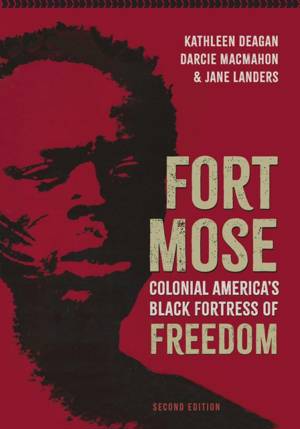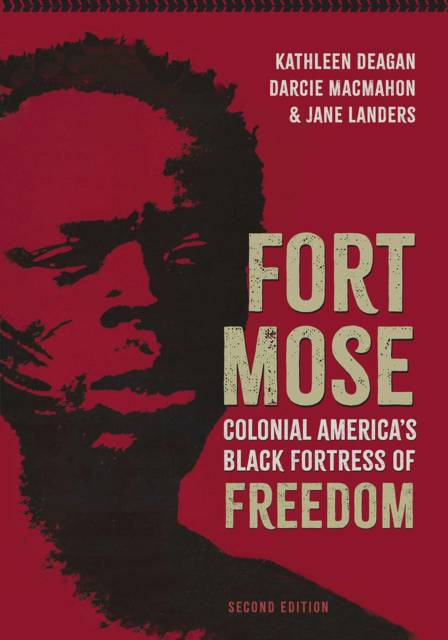
- Retrait gratuit dans votre magasin Club
- 7.000.000 titres dans notre catalogue
- Payer en toute sécurité
- Toujours un magasin près de chez vous
- Retrait gratuit dans votre magasin Club
- 7.000.0000 titres dans notre catalogue
- Payer en toute sécurité
- Toujours un magasin près de chez vous
Fort Mose
Colonial America's Black Fortress of Freedom, Second Edition
Kathleen Deagan, Darcie Macmahon, Jane Landers
37,45 €
+ 74 points
Description
The
illustrated story of the history and groundbreaking discovery of an important
historical site, fully updated on the 30th anniversary of its first publication Awards
and praise for the first edition: Florida
Historical Society Charlton Tebeau Book Award American
Association for State and Local History Award of Merit "Tells
the story of Fort Mose . . . as well as the story of the Black experience in
the American Spanish colonies."--Washington Post "A
very important chapter of the U.S. national story."--Colonial Latin
American Historical Review "An
excellently researched and presented book. . . . Deagan and MacMahon have done
a splendid job of bringing a little known story of African American struggle,
courage and success to the public."--Public Archaeology Review More
than 300 years ago, enslaved people of African descent risked their lives to
escape from slavery on English plantations in South Carolina. Hearing that
Spaniards in Florida promised religious sanctuary, they made their way south to
St. Augustine, Florida. The Spanish established the fort and town of Gracia
Real de Santa Teresa de Mose, the first legally sanctioned free Black community
in what is now the United States. This book tells the story of Fort Mose and
the people who lived there.
Fort Mose traces the roots of this eighteenth-century free
Black town from Africa through Iberia and Hispanic America to the colonial
southeastern United States. It also tells how archaeologists, historians, local
residents, teachers, and politicians worked together in the late twentieth
century to bring the rich but neglected history of free Black people in the
Spanish colonies to the public. The site of Fort Mose is now a major point on
the Florida Black Heritage Trail and has been designated a National Historic
Landmark and a UNESCO Site of Memory. Research continues at the location to the
present day.
This second edition is updated with new information
uncovered about Fort Mose, its inhabitants, and its historical significance. It
reflects recent developments in community involvement and preservation at the
site. And as the first edition did, it challenges the idea that the American Black
colonial experience was only that of slavery, offering a story of a courageous
group of people of African descent who realized their vision of
self-determination before the American Revolution.
illustrated story of the history and groundbreaking discovery of an important
historical site, fully updated on the 30th anniversary of its first publication Awards
and praise for the first edition: Florida
Historical Society Charlton Tebeau Book Award American
Association for State and Local History Award of Merit "Tells
the story of Fort Mose . . . as well as the story of the Black experience in
the American Spanish colonies."--Washington Post "A
very important chapter of the U.S. national story."--Colonial Latin
American Historical Review "An
excellently researched and presented book. . . . Deagan and MacMahon have done
a splendid job of bringing a little known story of African American struggle,
courage and success to the public."--Public Archaeology Review More
than 300 years ago, enslaved people of African descent risked their lives to
escape from slavery on English plantations in South Carolina. Hearing that
Spaniards in Florida promised religious sanctuary, they made their way south to
St. Augustine, Florida. The Spanish established the fort and town of Gracia
Real de Santa Teresa de Mose, the first legally sanctioned free Black community
in what is now the United States. This book tells the story of Fort Mose and
the people who lived there.
Fort Mose traces the roots of this eighteenth-century free
Black town from Africa through Iberia and Hispanic America to the colonial
southeastern United States. It also tells how archaeologists, historians, local
residents, teachers, and politicians worked together in the late twentieth
century to bring the rich but neglected history of free Black people in the
Spanish colonies to the public. The site of Fort Mose is now a major point on
the Florida Black Heritage Trail and has been designated a National Historic
Landmark and a UNESCO Site of Memory. Research continues at the location to the
present day.
This second edition is updated with new information
uncovered about Fort Mose, its inhabitants, and its historical significance. It
reflects recent developments in community involvement and preservation at the
site. And as the first edition did, it challenges the idea that the American Black
colonial experience was only that of slavery, offering a story of a courageous
group of people of African descent who realized their vision of
self-determination before the American Revolution.
Spécifications
Parties prenantes
- Auteur(s) :
- Editeur:
Contenu
- Nombre de pages :
- 160
- Langue:
- Anglais
- Collection :
Caractéristiques
- EAN:
- 9780813081007
- Date de parution :
- 02-09-25
- Format:
- Livre broché
- Format numérique:
- Trade paperback (VS)
- Dimensions :
- 173 mm x 157 mm
- Poids :
- 453 g

Les avis
Nous publions uniquement les avis qui respectent les conditions requises. Consultez nos conditions pour les avis.






